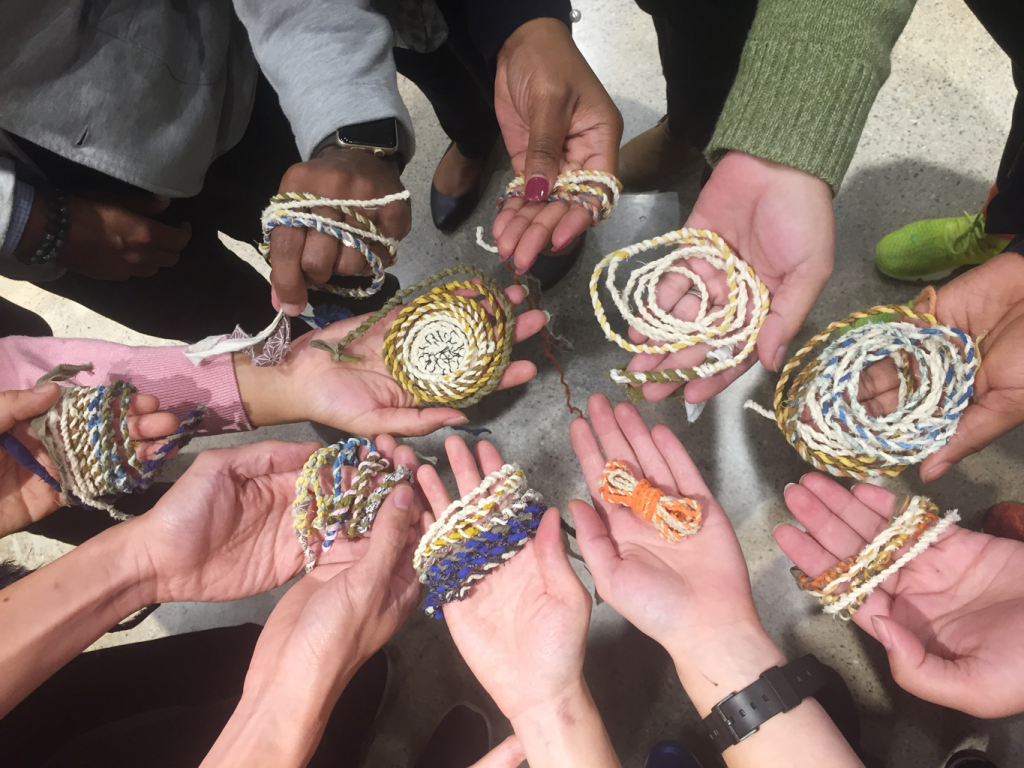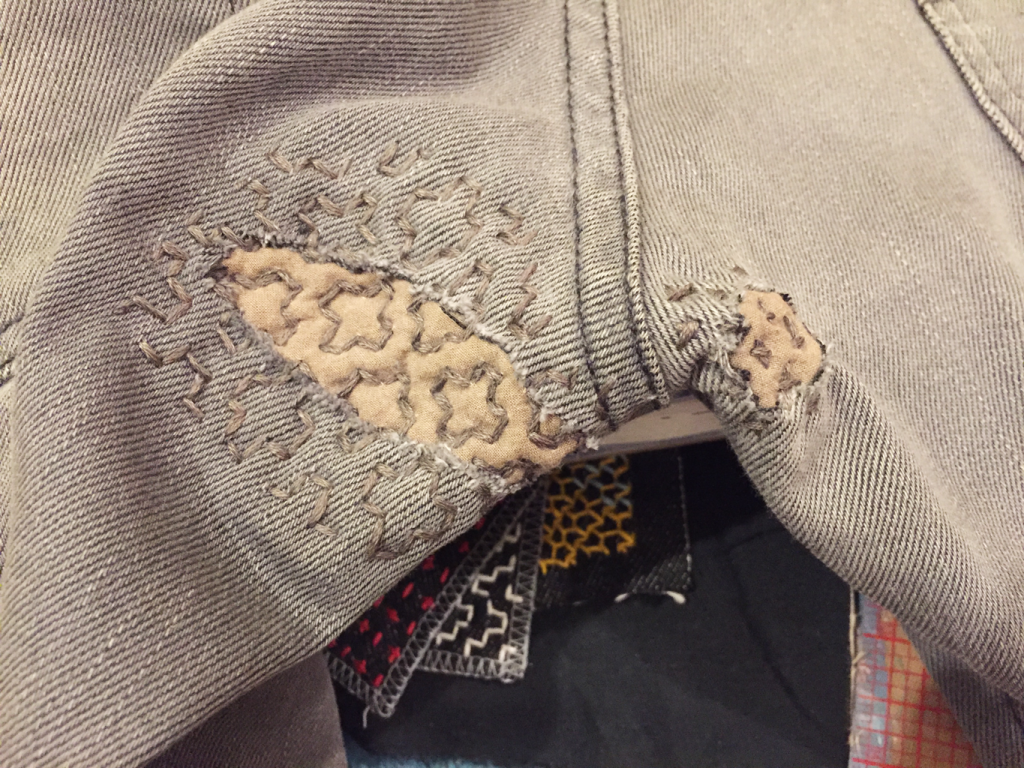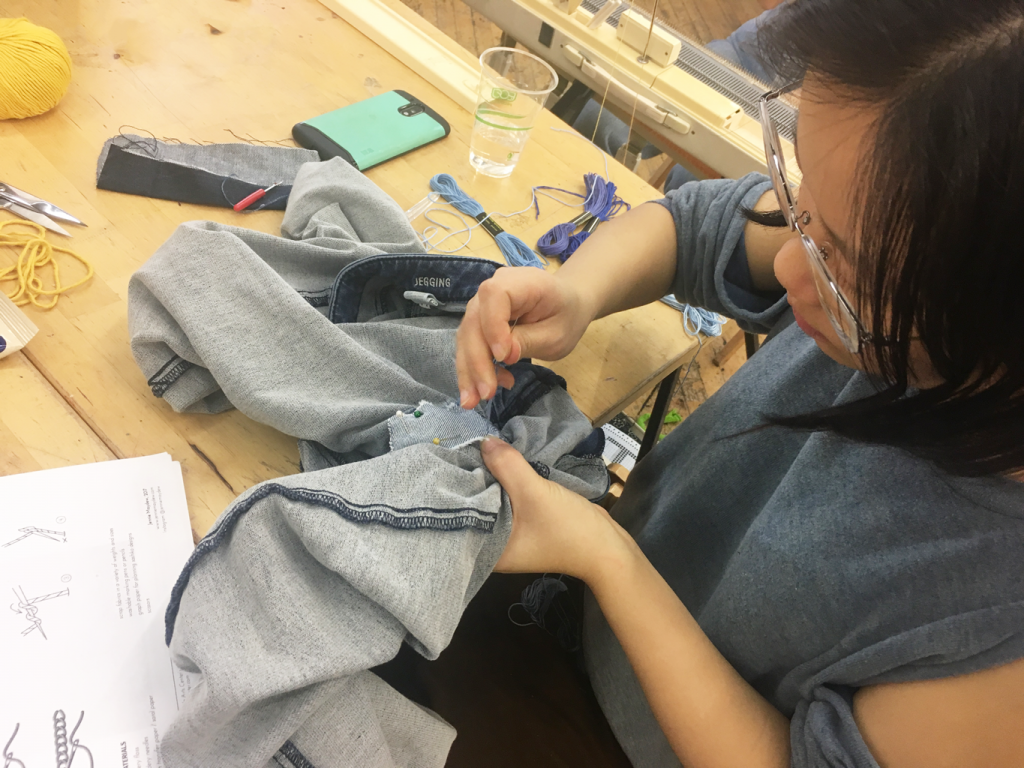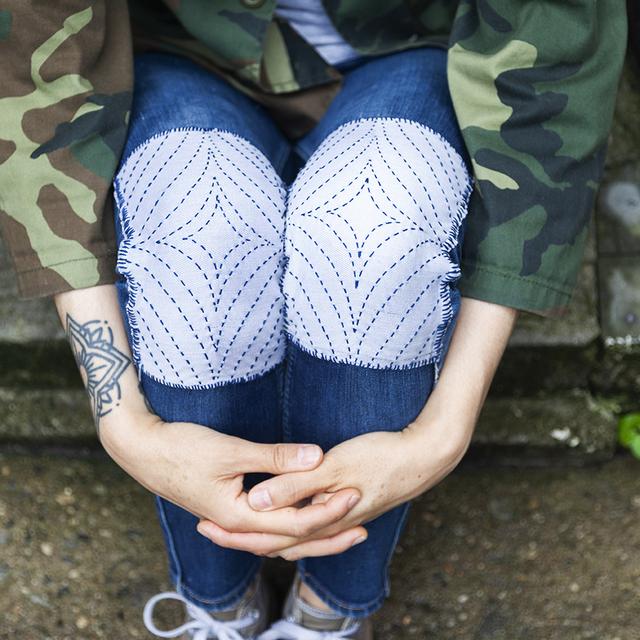Sustainable Fashion in Community Practice
Before the era of fast fashion and mass production of clothing, mending was a skill and practice men and women participated in on a regular basis. Most people bought fabric and made their own clothing. With a limited number of outfits, our resourceful predecessors spent the time caring for and repairing their clothing or repurposing the fabric to make something entirely new. While mending and darning to make the repair look invisible is common, visible-mending styles such as the traditional Japanese embroidery technique of Sashiko has experienced a resurgence in recent years for those looking to use mending as a form of self-expression and as an antidote to the excesses of the disposable fashion trends of today.

Make It, Mend It Club meets every third Thursday at Textile Arts Center’s Brooklyn Studio from 6:30-9:30 pm and we are calling all makers, menders, crafters, and creatives to join us in mending their old clothing, starting a new project, or finishing an old one. Tools and materials will be available to all, and bringing something to share with the whole group is encouraged - whether that be a donation, materials, snacks, drinks, or a friend! The next two meetings will be Thurs, May 16th and Thurs, June 20th when we will welcome the author of the Make + Mend book Jessica Marquez as our special guest for the evening.
The co-hosts of Make It, Mend It Club are artists and educators Victoria Manganiello, Jennie Maydew, and Linh My Truong. We caught up with them to discuss their connection to mending and vision for this social gathering of makers & menders.
What is your personal/artistic relationship to mending?
Victoria: I use mending techniques in my work as an artist and for the basic needs of the textiles in my everyday life. I love the “look” of visible mending and have found a lot of inspiration from traditional techniques. I’m an intuitive maker and so while the strict stitches don’t come naturally to me, I find there is a freedom within a framework and I like to take a method as something specific to translate.
Jennie: As a teenager, I taught myself to make clothes by altering thrift store garments. I admired how existing shapes and textures would respond to new alterations. Existing clothing also provided an accessible foundation for a beginner seamstress. Coming of age in my own creations developed my pride in owning one-of-a-kind clothing no one else was going to have. After moving to New York nearly a decade later, I internalized a mindset of easy consumption and easy disposal. City living explicitly encourages this kind of lifestyle. Mending became a mantra for slowing down. It increased my sense of value for resource- and labor-intensive objects. The concept of 'ritual' is steadily gaining significance in my practice, but I've always had an artist's intuition to reuse objects after their initial purpose is fulfilled. I am curious how mending can develop into ritual as we extend the lives of our garments and imbue them with value.
Linh: I grew up with parents who sewed professionally. My mother had her own children’s clothing line when I was young, and she gave me a great deal of leeway as a child to choose the color, style, and pattern of what she would make for me. As a result, I was taught very early on to use sewing and mending skills as a means to create custom clothing for myself and assert my personality into what I wear. I learned the value of materials over brand-name and began a vintage clothing obsession that continues today. Mending has become a method of personalization, self-care, and thoughtful adornment.
How do you incorporate sustainability into your practice?
Victoria: Whenever possible, I use upcycled materials or if new, sustainable materials that have been produced and sourced ethically. I also try to incorporate the conversation into my work and take any chance I can to share what I have learned about how we can be more responsible consumers. Conceptually, my artwork explores the relationships between natural and synthetic materials and how observing that binary can help us discover what’s possible between two extremes.
Jennie: My formal background is in natural dyes and weaving, and I have always been drawn to using natural materials in both of these processes. My current work utilizes traditional methods such as hand sewing, basketry, and natural dyeing. These skills have existed for millennia because of their sustainability toward communities, resources, and the earth. The continuity of craft depends on how eager people are to support it. Natural dyeing is popular right now because people are interested in learning about it. The practice of mending has experienced a similar resurgence–even to the point where contemporary "mending" can be purely decorative! Not only does Make It, Mend It Club build community, but it invites participation in the continuity of crafts and craftspeople.
Linh: Coming from a fashion background, I quickly became aware of the wasteful and unsustainable practices of the industry. As an artist, I make an effort to be conscious of materials and to use deadstock or sustainable materials as much as possible. As a sewing instructor, I try to share my knowledge of the industry to encourage students to create their own clothing using quality, sustainable materials and mend as much as possible to extend the life cycle of their clothing. Mending is a way of reconnecting with our clothing and valuing the skill and effort that goes into making it.
How does collaboration and sharing your practice with others aid your creative process?
Victoria: I am an educator. I love sharing what I know because I find it’s a way for me to learn. I want to live in an open source world where the success of one benefits the group and visa-versa. For me, textiles and textile makers might be the place in the art world for this to actually happen. Community and sharing are embedded so deeply into the practice of constructing and manipulating cloth.
Jennie: As a craftsperson and educator, I am uniquely positioned to advocate for skill development. I teach classes from the kindergarten to adult level and am always engaged in a cycle of learning, making, teaching, and re-learning. I am invested in skill sharing because it's an empowering experience for both the teacher and the learner.
Linh: As an artist, I am often caught in my own bubble of ideas. I mainly work independently on projects and yearn to collaborate with like-minded individuals. Teaching and sharing my practice gives me the ability to connect with others and return to a beginner’s mind, which is the state of greatest creative freedom. The best lessons I learn are often from children as they have the least inhibition to do things the “right” way.
What is driving you to create a social, community event centered around making?
Victoria: My ideal night is one sitting around a table with yarn, snacks, and friends. I’m not into bars and nightlife. I find so much joy in spending time doing something relaxing and also productive. I make things for my job so it’s also nice to take that activity I love and put it towards something that isn’t work. It’s a reminder of why I love what I do.
Jennie: Last year our co-collaborator Victoria developed a series of mending nights that she would host at her studio. Participation in these community-driven events increased the visibility of making and supported accountability in starting and finishing projects. Make It, Mend It Club directly developed from Victoria's mending series. Textiles are really engaging for people. If you've ever knit or crocheted on a crowded subway (or seen someone doing it) you know exactly what I mean. Despite our digitized world, most people still know someone with a textile practice or they themselves own a handmade textile object–maybe a quilt, needlepoint, or hand-sewn Halloween costume. I envision Make It, Mend It Club as a dedicated environment for curiosity, collaboration, visibility, and accountability. People have been gathering to do textile work for thousands of years. It made sense for us to do it together, too.
Linh: There is something really special and wonderful about doing an activity individually but together with a group of people. I love to see what others are working on and being inspired by the different voices around the table. Mending, in particular, is something easy enough for anyone to pick up and add their own spin on it. It also does not take up that much space, so it encourages a physical closeness with the group. Extending the focus of the group to making anything allows for greater flexibility and openness in the projects that come to the table, and the emphasis remains simply on coming together with others to make something with your own two hands.


